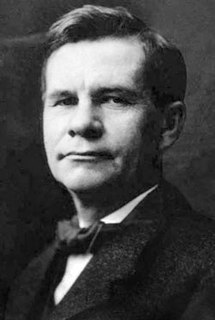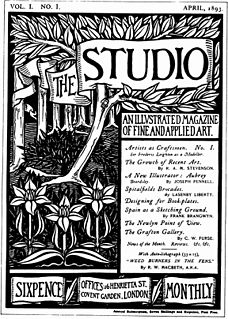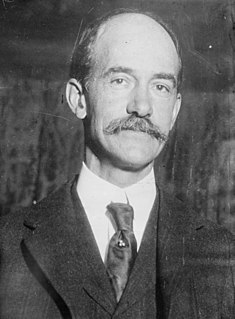
The Arts and Crafts movement was an international trend in the decorative and fine arts that developed earliest and most fully in the British Isles and subsequently spread across the British Empire and to the rest of Europe and America.
Paul Edmund Soldner was an American ceramic artist and educator, noted for his experimentation with the 16th-century Japanese technique called raku, introducing new methods of firing and post firing, which became known as American Raku. He was the founder of the Anderson Ranch Arts Center in 1966.

Gustav Stickley was an American furniture manufacturer, design leader, publisher, and a leading voice in the American Arts and Crafts movement. Stickley's design philosophy was a major influence on American Craftsman architecture.

2 Columbus Circle is a 12-story building located on a small trapezoidal lot on the south side of Columbus Circle on the Upper West Side of Manhattan, New York City. Bordered by 58th Street, 59th Street, Broadway, and Eighth Avenue, it stands on the site of the former seven-story Grand Circle Hotel. It opened in 1964, after A&P heir Huntington Hartford hired architect Edward Durell Stone to build a museum for him at the site. Controversy was sparked in 2002 after the Museum of Arts and Design (MAD) purchased the building and planned to significantly alter its design, including modifying its facade. Calls had been made since 1996 for the building to be landmarked, so its proposed landmark status was brought into question with this renovation. The renovations were completed in 2008.

American craft is craft work produced by independent studio artists working with traditional craft materials and processes. Examples include wood, glass, clay (ceramics), textiles, and metal (metalworking). Studio craft works tend to either serve or allude to a functional or utilitarian purpose, although they are just as often handled and exhibited in ways similar to visual art objects.

American Craftsman is an American domestic architectural style, inspired by the Arts and Crafts movement, which included interior design, landscape design, applied arts, and decorative arts, beginning in the last years of the 19th century. Its immediate ancestors in American architecture are the Shingle style, which began the move away from Victorian ornamentation toward simpler forms; and the Prairie style of Frank Lloyd Wright. The name "Craftsman" was appropriated from furniture-maker Gustav Stickley, whose magazine The Craftsman was first published in 1901. The architectural style was most widely-used in small-to-medium-sized Southern California single-family homes from about 1905, so that the smaller-scale Craftsman style became known alternatively as "California bungalow". The style remained popular into the 1930s, and has continued with revival and restoration projects through present times.

The Museum of Arts and Design (MAD), based in Manhattan, New York City, collects, displays, and interprets objects that document contemporary and historic innovation in craft, art, and design. In its exhibitions and educational programs, the Museum celebrates the creative process through which materials are crafted into works that enhance contemporary life.

The Studio: An Illustrated Magazine of Fine and Applied Art was an illustrated fine arts and decorative arts magazine published in London from 1893 until 1964. The founder and first editor was Charles Holme. The magazine exerted a major influence on the development of the Art Nouveau and Arts and Crafts movements. It was absorbed into Studio International magazine in 1964.

The Craftsman was a magazine founded by the American furniture designer Gustav Stickley that championed the American Arts and Crafts movement.
William Henry Osborn was a 19th-century American businessman and philanthropist. He was a railroad tycoon who became one of the most prominent railroad leaders in the United States.

William Church Osborn was the son of a prominent New York City family who served in a variety of civic roles including president of the Metropolitan Museum of Art, president of the Children's Aid Society, and president of the New York Society for the Relief of the Ruptured and Orphaned.

The American Craft Council (ACC) is a national non-profit organization that champions craft based in Minneapolis, Minnesota. Founded in 1943 by Aileen Osborn Webb, the council hosts national craft shows and conferences, publishes a bi-monthly magazine called American Craft and a quarterly journal called American Craft Inquiry, maintains an extensive awards program, and is home to a comprehensive library and archives.

Tom Joyce is a sculptor and MacArthur Fellow known for his work in forged steel and cast iron. Using skills and technology acquired through early training as a blacksmith, Joyce addresses the environmental, political, and social implications of using iron in his work. Exhibited internationally since the 1980s, his work is included in 30-plus public collections in the U.S. and abroad. Joyce works from studios in Santa Fe, New Mexico, and since 2012, in Brussels, Belgium, producing sculpture, drawings, prints, photographs, and videos that reference themes of iron in the human body, iron in industry, and iron in nature.
The World Crafts Council AISBL (WCC-AISBL) is a non-profit, non-governmental organization that was founded in 1964 to promote fellowship, foster economic development through income generating craft related activities, organize exchange programs, workshops, conferences, seminars, and exhibitions—and in general, to offer encouragement, help, and advice to the craftspersons of the world. The organization is now formally registered in Belgium as an international organization and AISBL is there the French shortcut for an international association without lucrative purpose. The WCC is organised into five regions: Africa, Asia Pacific, Europe, Latin America, and North America. The organization is affiliated to UNESCO.

Aileen Osborn Webb (1892–1979) was an American aristocrat and a patron of crafts. She was a founder of the organization now known as the American Craft Council, which gives an annual award named for her. She was considered a "principal supporter" of the American Craft movement during the Great Depression. She founded the School of the American Craftsman (SAC), which is now part of Rochester Institute of Technology (RIT).
Paul J. Smith was an arts administrator, curator, and artist based in New York. Smith was professionally involved with the art, craft, and design fields since the early 1950s and was closely associated with the twentieth-century studio craft movement in the United States. He joined the staff of the American Craftsmen's Council in 1957, and in 1963 was appointed Director of the Museum of Contemporary Crafts, a position he held for the next 24 years. In September 1987, he assumed the title of director emeritus and continued to work as an independent curator and consultant for museums, arts organizations, and collectors.

Emil Milan was an American woodworker known for his carved bowls, birds, and other accessories and art in wood. Trained as a sculptor at the Art Students League of New York, he designed and made wooden ware in the New York City metropolitan area, and later in rural Pennsylvania where he lived alone and used his barn as a workshop. Participating in many woodworking, craft, and design exhibits of his day, his works are in the Smithsonian American Art Museum and Renwick Gallery, the Yale Art Gallery, the Center for Art in Wood, the Museum of Art and Design, and many private collections. Once prominent in midcentury modern design, Milan slipped into obscurity after his death. His legacy has been revived by an extensive biographical research project that has led to renewed interest in his life, work, and influence.
Rose Slivka was an American poet and writer for women's magazines in the twentieth century. From 1959 to 1979 she was the editor-in-chief for Craft Horizons.

Azalea Thorpe was a Scottish-born American weaver and textile designer. Known for her innovative experimentation with both natural and synthetic materials, Thorpe was a featured instructor and lecturer throughout the United States. She has weavings in the permanent collection of the Victoria and Albert Museum. An annual award given in her honor is presented by the Institute of American Indian Arts for fiber arts.
Adda "Andy" Thyra Elise Louise Husted-Andersen was a Danish-born American Modernist jeweler, silversmith, metalsmith, and educator. She was a co-founder and the president of the New York Society of Craftsmen from 1941 to 1944. She was a master of working with enamel, silver and gold. She was active in New York City and Copenhagen.
















